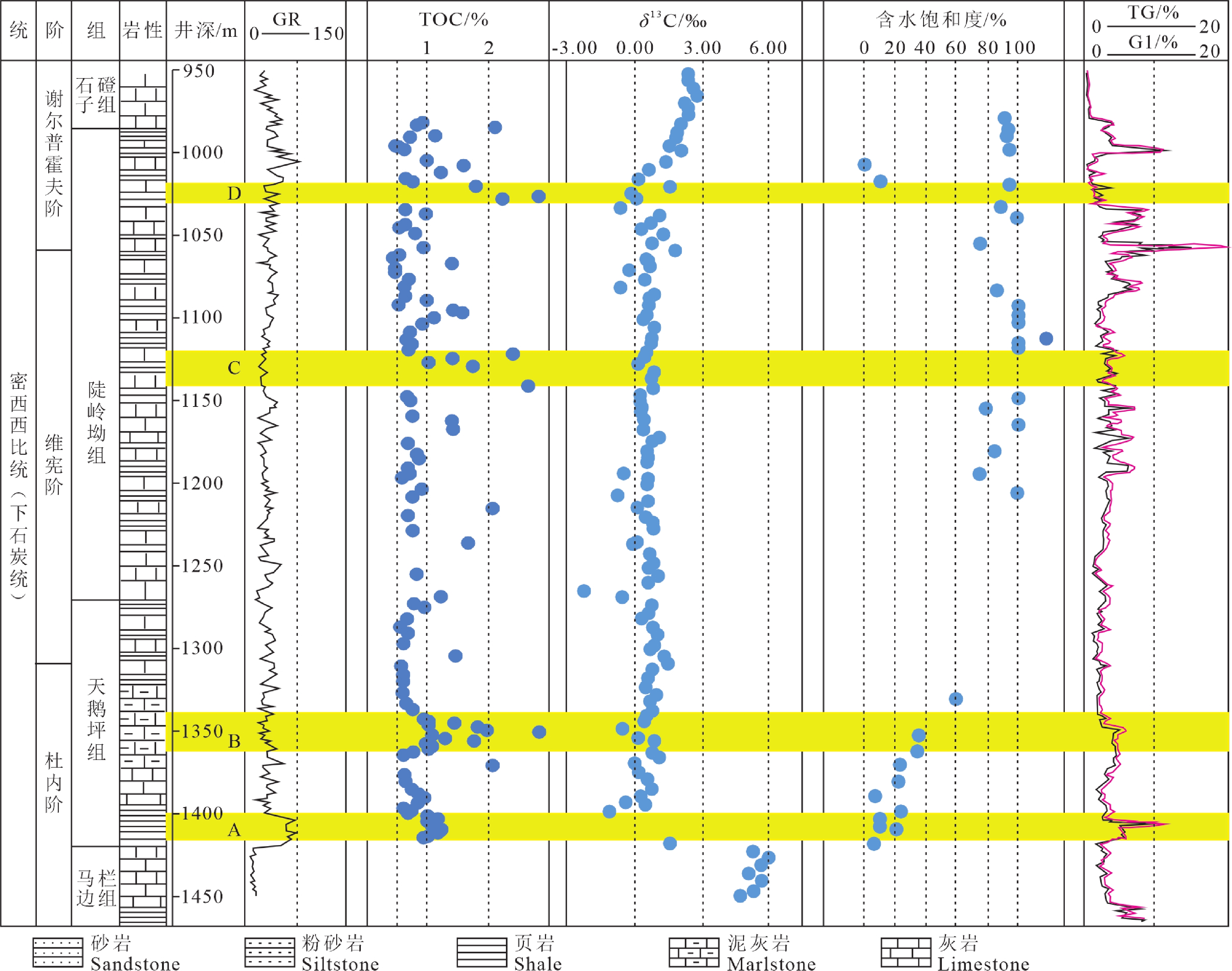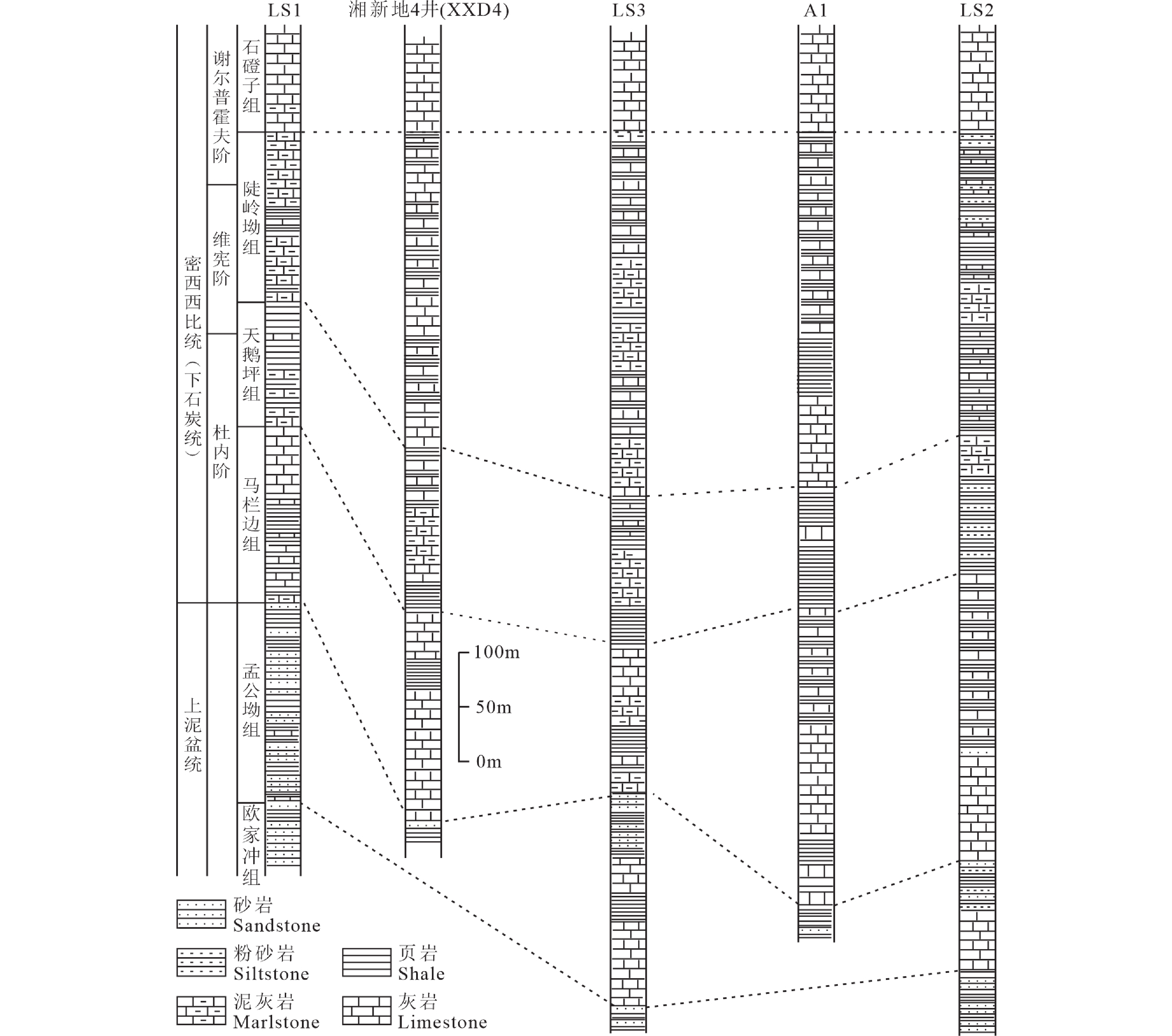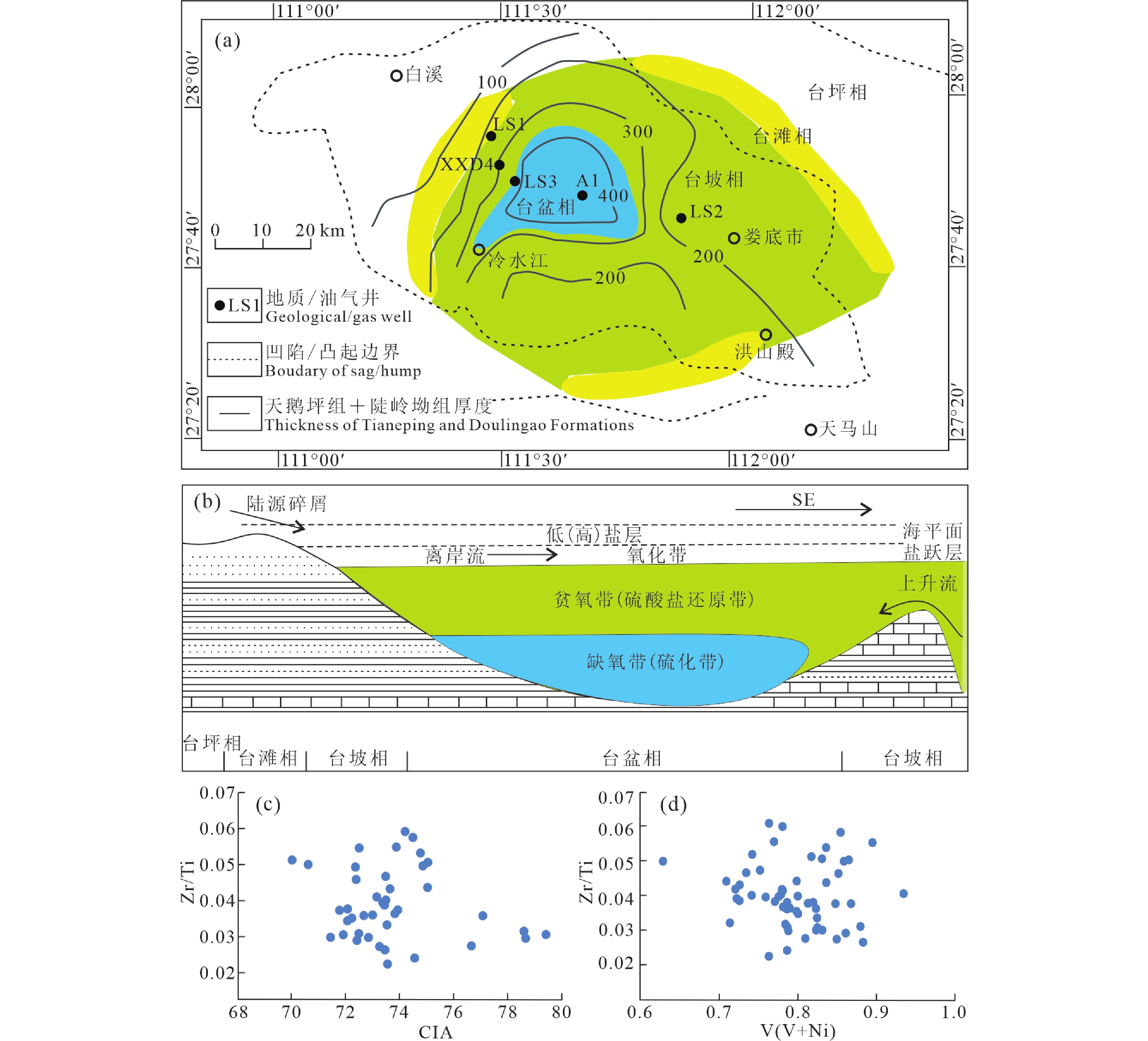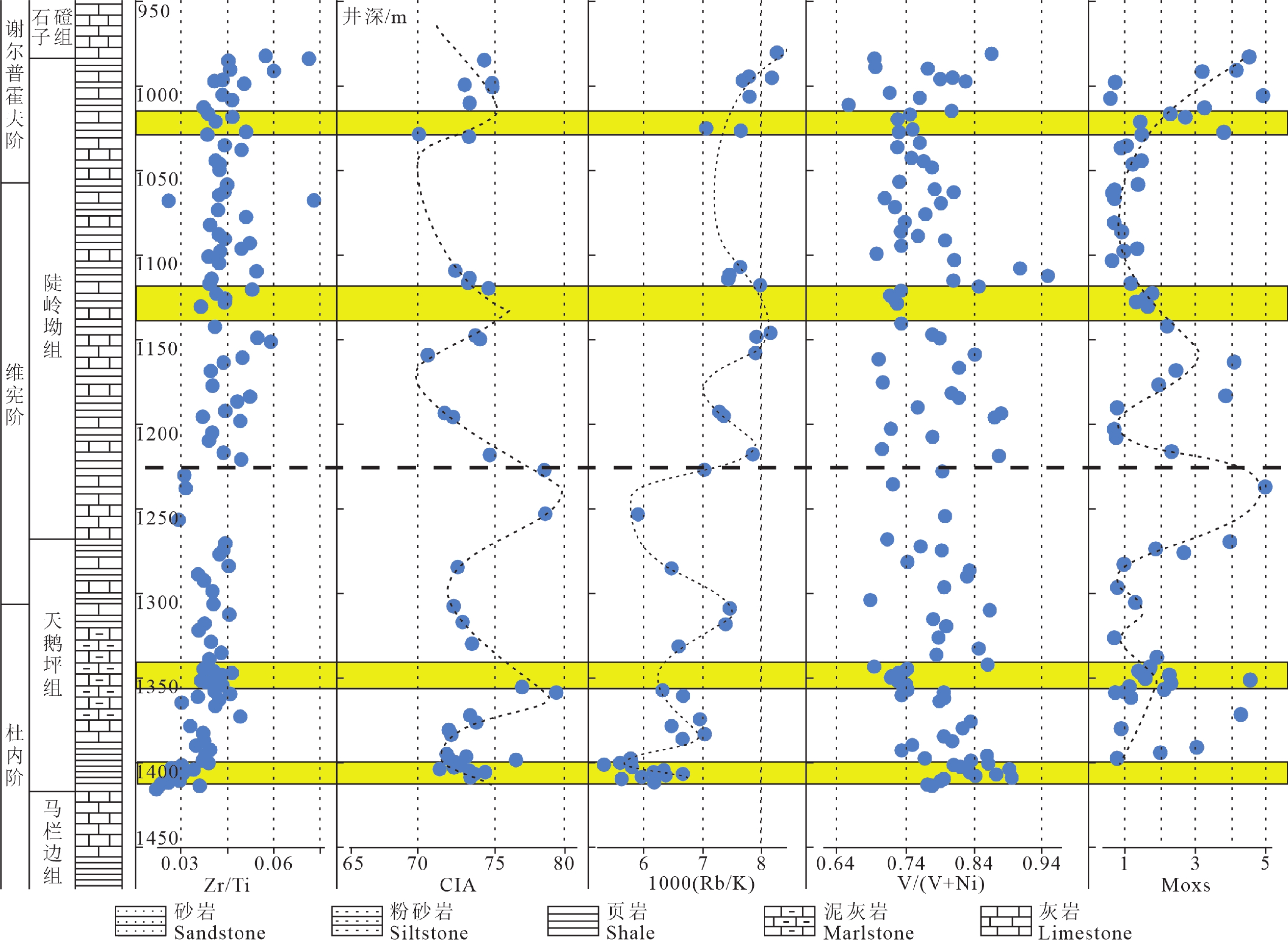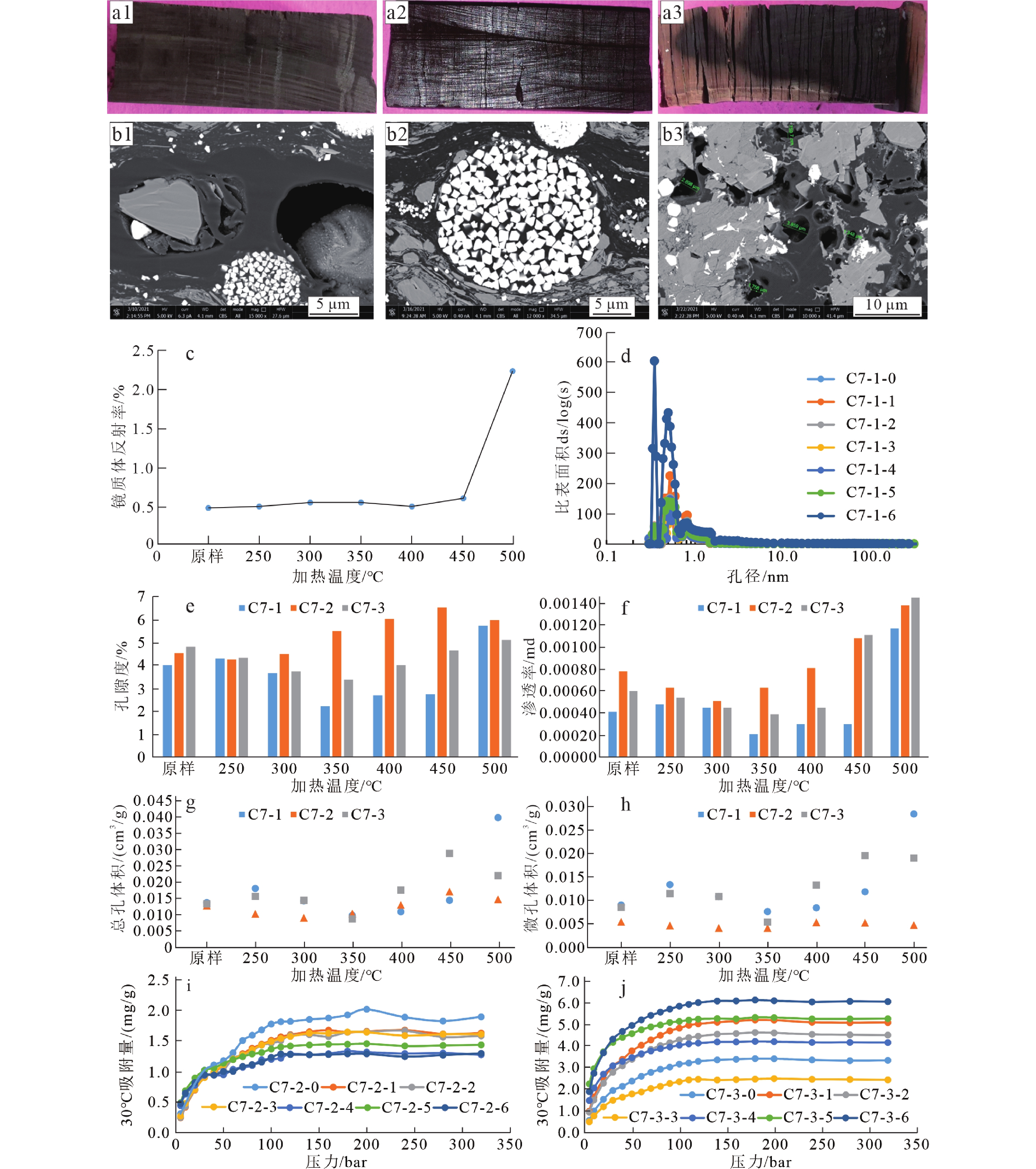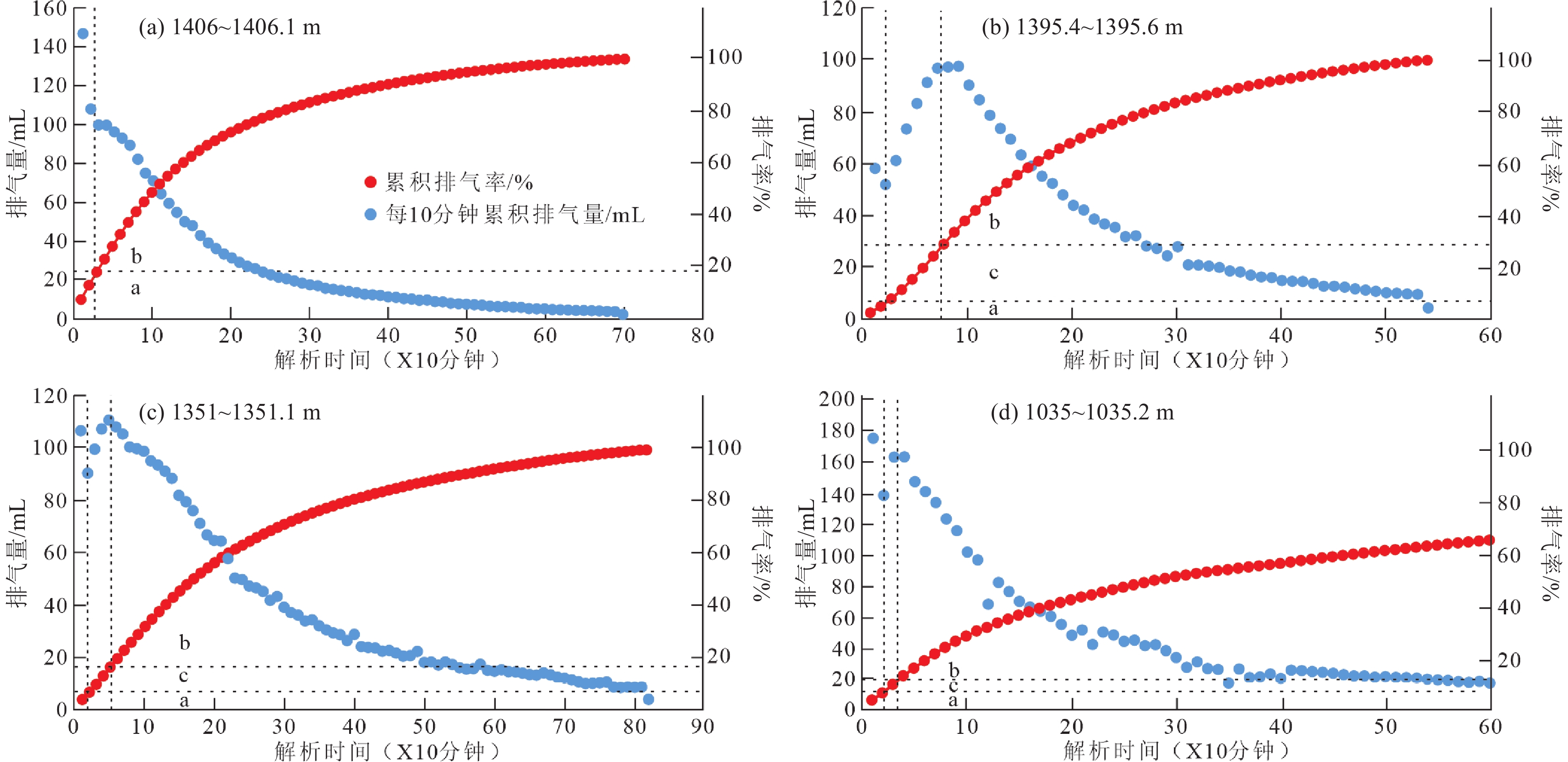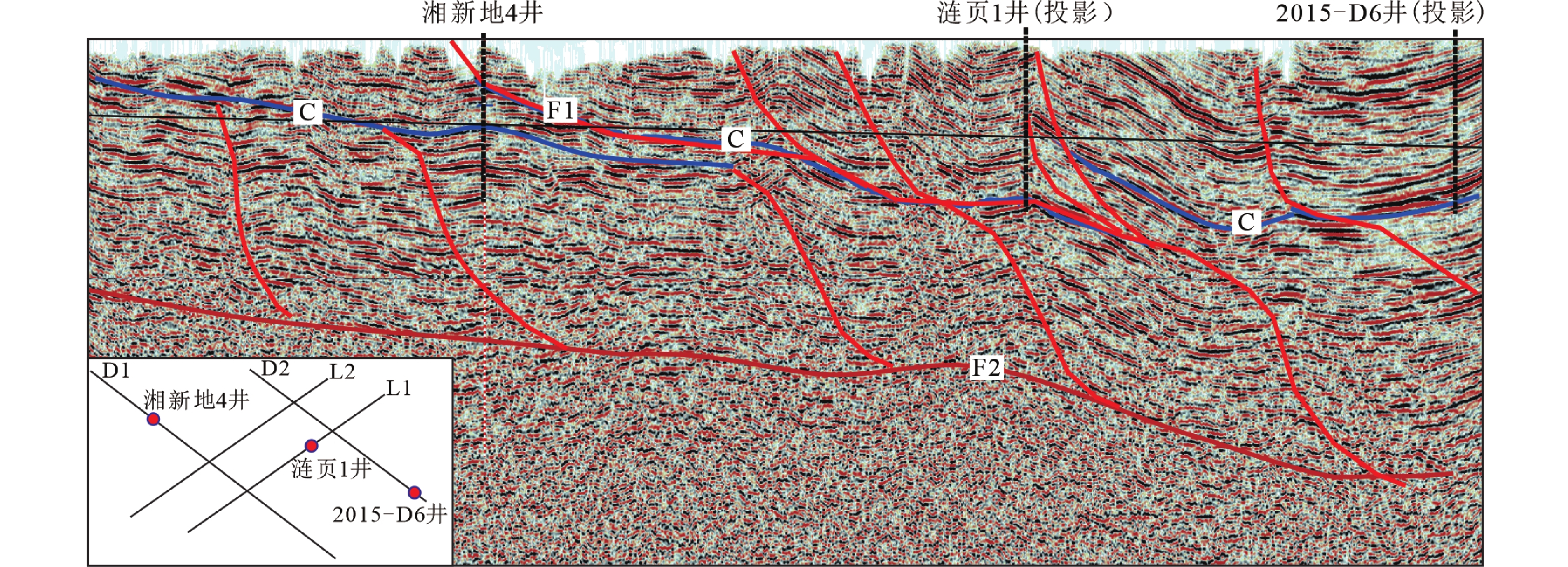Mechanism of organic-rich shale formation and shale gas enrichment in the Carboniferous Tian’eping Formation from the Xiangzhong Depression
-
摘要:研究目的
本文旨在通过页岩成因和页岩气富集机理研究,确定湘中坳陷下石炭统天鹅坪组页岩气形成富集主控因素和富集模式。
研究方法以湘新地4井为重点,通过下石炭统碳酸盐岩稳定碳、氧同位素、页岩全岩氧化物和微量元素含量测定,分析页岩形成的古气候、古环境特点,确定富有机质页岩的成因。在系统查明页岩岩石矿物学、有机地化和储存物性特征以及页岩气赋存方式和构造保存条件基础上,结合中—低成熟页岩储存的热演化模拟结果,确定页岩气富集机理。
研究结果(1)下石炭统天鹅坪组富有机质页岩是全球早石炭世杜内期气候剧烈波动引起海水分层,海底缺氧的沉积产物。(2)涟源地区中生代广泛而强烈的岩浆事件导致区域古地温梯度升高,并引起天鹅坪组页岩发生二次生烃和储层物性的改善。天鹅坪组页岩气是印支期油气调整后,页岩中原油裂解和有机质二次生烃的共同结果。(3)发育在下石炭统测水煤系中的滑脱构造部分封堵了下伏天鹅坪组页岩气的垂直逸散通道,有利于页岩气的保存富集。
结论湘中坳陷下石炭统天鹅坪组页岩气是有利相带控制总有机碳含量、岩浆热作用控制储层物性和滑脱构造控制保存的共同结果。
创新点:(1)气候重大转折期古大陆边缘凹陷盆地是页岩气勘探的有利相带;(2)岩浆热作用制约区域页岩有机质热演化程度和页岩气储存的品质;(3)滑脱构造下盘是页岩气勘探的最有利区域。
Abstract:This paper is the result of oil and gas exploration engineering.
ObjectiveThrough the study of shale formation and shale gas enrichment mechanism, the current study aims at finding out main factor controlling shale gas reservoir in the Carboniferous Tian’eping Formation in the Xiangzhong Depression as well as its enrichment patterns.
MethodsCarbonates carbon and oxygen isotopes as well as shale trace elements and major elements were analyzed at Xiangxindi 4 core in order to recover paleo−environment and investigate the origin for the shale formation. Combined with the thermal evolution simulation of medium−low maturity shale gas reservoirs, the mechanism for shale gas enrichment is identified through petromineralogy, organic geochemistry, physical properties of shale gas reservoirs, existence forms of shale gas and tectonic preservation condition.
Results(1) The organic−rich shale in Lower Carboniferous Tian’eping Formation were formed due to seawater stratification and seabed anoxia caused by the intensive climatic fluctuations in the Early Carboniferous. (2) The extensive and intense magmatic events in central Hunan led to the increase of locally paleogeothermal gradient and further caused secondary hydrocarbon generation in the Lower Carboniferous organic−rich shale. Shale gas in the Tian’eping Formation was formed owing to crude oil cracking and secondary hydrocarbon generation of organic matter. (3) Shale gas preservation was promoted due to decollement in the Ceshi Formation of the lower Carboniferous blocking the vertical escaping channel of the shale gas from the underlying Tian’eping Formation.
ConclusionsThe shale gas of Lower Carboniferous Tian’eping Formation in central Hunan Depression is the common result of favorable facies zone controlling the total organic carbon content, magmatic thermogenesis controlling the reservoir physical properties and detachment structure controlling the preservation.
Highlights:(1) Paleo depression in the continental margin during the major climate transition period is benefit for shale gas exploration. (2) Organic matter thermal evolution in regional shale and shale gas preservation are limited by magmatism. (3) The decollement footwall is the most favorable area for shale gas exploration.
-
-
图 4 湘中下石炭统富有机质页岩形成的古地理、古环境与古气候指标
a—岩相古地理图;b—沉积相模式示意图;c—Zr/Ti–CIA相关性图;d—Zr/Ti–V/(V+Ni)相关性图
Figure 4. Palaeogeography, palaeoenvironment and palaeoclimate index of the formation of organic-rich shale in the Lower Carboniferous in Central Hunan Province
a–Lithofacies paleogeographic map; b–Schematic diagram of sedimentary facies model; c–Correlogram of Zr/Ti–CIA; d–Correlogram of Zr/Ti–V/(V+Ni)
图 6 不同模拟温度下页岩储层的物性和含气性特点
a—C7−1的形貌变化:a1—原始样品,a2—300℃,a3—500℃;b—C7−1有机质分布特点:b1—350℃有机质与矿物颗粒间孔,b2—400℃黄铁矿晶体间有机质,b3—450℃有机孔;c—C7−1沥青反射率;d—C7−1组孔体积分布图;e—孔隙度分布图;f—渗透率分布图;g—总孔体积对比图;h—微孔体积对比图;i—C7−2组甲烷等温吸附曲线图;j—C7−3组甲烷等温吸附曲线图
Figure 6. Physical and gas properties of shale reservoirs at different simulated temperatures
a–Morphologic change of sample C7−1: a1–Primitive sample, a2–300℃, a3–500℃; b–Distribution of the organic matter in sample C7−1: b1–The pore between the organic matter and mineral grain at 350℃; b2–The pyrite intergranular pores filled with organic matter at 400℃, b3–Organic pore at 450℃; c–Bitumen reflectance of sample C7−1; d–Pore volume of sample C7−1; e–Porosity; f–Permeability; g–The total pore volume; h–Micropore volume; i–Isothermal adsorption curve of methane of sample C7−2; j–Isothermal adsorption curve of methane of sample C7−3
图 8 湖南涟源下石炭统页岩气双冲断裂夹块控藏模式图
F1—测水组内部顺层逆冲断裂;F2—泥盆系底部逆冲断裂带;C—测水组底界;D, L—二维地震测线
Figure 8. Controlling reservoir model of the Lower Carboniferous shale gas in Lianyuan, Hunan Province
F1–Bedding thrust fault within the Ceshui Formation; F2–Thrust fault at the base of the Devonian; C–The base of the Ceshui Formation; D, L–2D seismic line
-
[1] Abouelresh M O, Slatt R M. 2012. Lithofacies and sequence stratigraphy of the Barnett Shale in east–central Fort Worth Basin, Texas[J]. AAPG Bulletin, 96: 1−22. doi: 10.1306/04261110116
[2] Armstrong H A, Abbott G D, Turner B R, Makhlouf I M, Muhammad A B, Pedentchouk N, Peters H. 2009. Black shale deposition in an Upper Ordovician–Silurian permanently stratified, peri–glacial basin, southern Jordan[J]. Palaeogeography, Palaeoclimatology, Palaeoecology, 273: 368–377.
[3] Bi Hua, Peng Gelin, Yang Minghui. 1996. The thermal history and hydrocarbon–generating characteristics of Ceshui and Longtan coal series in Lianyuan, Hunan Province[J]. Journal of East China Geological Institute, 19(2): 157−161 (in Chinese with English abstract).
[4] Brezinski D K, Cecilb C B, Skema V W, Stamm R. 2008. Late Devonian glacial deposits from the eastern United States signal an end of the mid–Paleozoic warm period[J]. Palaeogeography, Palaeoclimatology, Palaeoecology, 268: 143–151.
[5] Chen Lin, Zhang Baomin, Chen Xiaohong, Jiang Shu, Zhang Guotao, Li Hai, Chen Ping, Lin Weibing. 2021. Lithofacies and origin evolution of mudstone of Shetianqiao Formation in Shaoyang Sag of Xiangzhong Depression[J]. Earth Science, 46(4): 1282−1294 (in Chinese with English abstract).
[6] Chen Xiaohong, Wei Kai, Zhang Baoming, Li Peijun, Li Hai, Liu An, Luo Shengyuan. 2018a. Main geological factors controlling shale gas reservoir in the Cambrian Shuijingtuo Formation in Yichang of Hubei Province as well as its and enrichment patterns[J]. Geology in China, 45(2): 207−226 (in Chinese with English abstract).
[7] Chen Xiaohong, Zhang Baomin, Chen Lin, Zhang Guotao, Li Peijun, Zhang Miao. 2018b. Main geological controlling factors and enrichment pattern of shale gas reservoirs in the Late Ordovician–Early Silurian strata of Yichang, Western Hubei Province[J]. Acta Geoscientica Sinica, 39(3): 257−268 (in Chinese with English abstract).
[8] Cheng K Y, Elrick M, Romaniello S J. 2020. Early Mississippian Ocean anoxia triggered organic carbon burial and late Paleozoic cooling: Evidence from uranium isotopes recorded in marine limestone[J]. Geology, 48(4): 363−367. doi: 10.1130/G46950.1
[9] Cheng Shunbo, Fu Jianming, Ma Liyan, Lu Youyue, Kou Xiaohu, Zhang Liguo and Huang Huilan. 2016. Origin of the Yuechengling Caledonian granitic batholith, Northeastern Guangxi: Constraint from zircon U–Pb geochronology, geochemistry and Nd–Hf isotopes[J]. Geotectonica et Metallogenia, 40(4): 853−872 (in Chinese with English abstract).
[10] Garzanti E, Sciunnach D. 1997. Early Carboniferous onset of Gondwanian glaciation and Neo–Tethyan rifting in South Tibet[J]. Earth and Planetary Science Letters, 148: 359−365. doi: 10.1016/S0012-821X(97)00028-9
[11] Hance L, Muchez P H, Coen M, Fang X S, Groessens E, Hou H, Poty E, Steemans P H, Streel M, Tan Z, Tourneur F, Steenvinkel V M, Xu S C. 1993. Biostratigraphy and sequence stratigraphy at the Devonian–Carboniferous transition in southern China (Hunan Province); Comparison with southern Belgium[J]. Annales de la Societe Geologique de Belgigue, 116: 359−378.
[12] Hatch J R, Leventhal J S. 1992. Relationship between inferred redox potential of the depositional environment and geochemistry of the Upper Pennsylvanian (Missourian) Stark shale member of the Dennis limestone, Wabaunsee County, Kansas, U. S. A.[J]. Chemical Geology, 99: 65−82. doi: 10.1016/0009-2541(92)90031-Y
[13] He Hongsheng. 2004. On Ceishui Formation’s bedding structure and decollement structure of Lianyuan Depression in Central Hunan Province[J]. Journal of Xiangtan Normal University (Natural Science Edition), 26(2): 32−36 (in Chinese with English abstract).
[14] Isaacson P E, Díaz–Martínez E, Grader G W, Kalvoda J, Babek O, Devuyst F X. 2008. Late Devonian–earliest Mississippian glaciation in Gondwanaland and its biogeographic consequences[J]. Palaeogeography, Palaeoclimatology, Palaeoecology, 268: 126–142.
[15] Jin Zhijun, Zhang Jinchuan, Wang Zhixin. 2003. Some remarks on deep basin gas acumination[J]. Geological Review, 49(4): 100−107 (in Chinese with English abstract).
[16] Li Cai, Xie Yaowu, Jiang Guangwu, Shi Jianrong, Wang Sunsheng. 2008. Glacial–marine diamictite of Gondwana facies in the Gyitangana, eastern Tibet, China, and its significance[J]. Geological Bulletin of China, 27: 1654−1658.
[17] Liu Jianqing, Xie Yuan, Zhao Zhan, Lin Jiashan, Feng Weiming, Huang Xueping. 2013. The Geochronologic characteristics of Baimashan granite in western Hunan Province and its geotectonic significance[J]. Earth Science Frontiers, 20(5): 25−35 (in Chinese with English abstract).
[18] Loucks R G, Ruppel S C. 2007. Mississippian Barnett shale: Lithofacies and depositional setting of a deep–water shale–gas succession in the Fort Worth Basin, Texas[J]. AAPG Bulletin, 91: 579−601. doi: 10.1306/11020606059
[19] Miao Fengbin, Tan Hui, Wang Qiang, Bai Yunshan, Peng Zhongqin. 2016. Preservation conditions in shale gas of Carboniferous Ceshui Formation of Lianyuan Depression in the Middle of Hunan Province[J]. Geological Science and Technology Information, 25(6): 90−97 (in Chinese with English abstract).
[20] Mii H S, Grossman E L, Yancey T E. 1999. Carboniferous isotope stratigraphies of North America: Implications for Carboniferous paleoceanography and Mississippian glaciation[J]. GSA Bulletin, 111(7): 960−973. doi: 10.1130/0016-7606(1999)111<0960:CISONA>2.3.CO;2
[21] Nesbitt H W, Young G M. 1982. Early Proterozoic climates and plate motions inferred from major element chemistry of lutites[J]. Nature, 299: 715−717. doi: 10.1038/299715a0
[22] Nesbitt H W, Young G M. 1989. Formation and diagenesis of weathering profiles[J]. Journal of Geology, 97: 129−147. doi: 10.1086/629290
[23] Qie W K, Liu J S, Chen J T, Wang X D, Mii H S, Zhang X H, Huang X, Yao L, Algeo T J, Luo G M. 2015. Local overprints on the global carbonate δ13C signal in Devonian–Carboniferous boundary successions of South China[J]. Palaeogeography, Palaeoclimatology, Palaeoecology, 418: 290–303.
[24] Saltzman M R, González L A, Lohmann K C. 2000. Earliest Carboniferous cooling step triggered by the Antler orogeny[J]. Geology, 28: 347−350.
[25] Scheffler K, Buehmann D, Schwark L. 2006. Analysis of Late Palaeozoic glacial to postglacial sedimentary successions in South Africa by geochemical proxies: Response to climate evolution and sedimentary environment[J]. Palaeogeography, Palaeoclimatology, Palaeoecology, 240: 184–203.
[26] Tan Zhengxiu, Zhu Lunjie, Ren Xiaohua, Li Guobiao. 1994. On the Menggong’ao Formation[J]. Regional Geology of China, (2): 165−171 (in Chinese with English abstract).
[27] Tian Wei, Peng Zhongqin, Wang Baozhong, Wang Qiang, Miao Fengbin, Liu Feiyu. 2019. Reservior characteristics and exploration potential of Lower Carboniferous shale gas in Lianyuan sag, Central Hunan[J]. Earth Science, 44(3): 939−952 (in Chinese with English abstract).
[28] Tian Wei, Wang Chuanshang, Bai Yunshan, Li Peijun. 2019b. Shale geochemical characteristics and enrichment mechanism of organic matter of the Upper Devonian Shetianqiao Formation shale in Lianyuan Sag, Central Hunan[J]. Earth Science, 44(11): 3794−3811 (in Chinese with English abstract).
[29] Wang Kaiming, He Xipeng, Xu Yuping, Jin We. 2021. Geological characteristics of shale gas in Dalong Formation of Well Xiangye 1 in Lianyuan sag, Xiangzhong depression[J]. China Petroleum Exploration, 26(1): 86−98 (in Chinese with English abstract).
[30] Wang Xianfeng, Peng Jun, Yu Ledan, Xu Tianyu. 2020. A review of the research methods of paleosalinity geochemistry in continental strata[J]. Acta Geologica Sichuan, 40(2): 301−308.
[31] Yang Jun, Bai Daoyuan, Wang Xianhui, He Jiangnan. 2015. Zircon SHRIMP U–Pb dating and geochemistry of Caledonian Baimashan pluton and its tectonic significance[J]. Geology and Mineral Resources of South China, 31(1): 48−56 (in Chinese with English abstract).
[32] Yao L, Qie W K, Luo G M, Liu J S, Algeo T J, Bai X, Yang B, Wang X D. 2015. The TICE event: Perturbation of carbon–nitrogen cycles during the mid–Tournaisian (Early Carboniferous) greenhouse–icehouse transition[J]. Chemical Geology, 401: 1−14. doi: 10.1016/j.chemgeo.2015.02.021
[33] 毕华, 彭格林, 杨明慧. 1996. 涟源地区测水组、龙潭组煤热演化史及生烃特征[J]. 华东地质学院学报, 19(2): 157−161. [34] 陈林, 张保民, 陈孝红, 蒋恕, 张国涛, 李海, 陈平, 林卫兵. 2021. 湘中坳陷邵阳凹陷佘田桥组泥岩岩相及其成因演化[J]. 地球科学, 46(4): 1282−1294. [35] 陈孝红, 危凯, 张保民, 李培军, 李海, 刘安, 罗胜元. 2018a. 湖北宜昌寒武系水井沱组页岩气藏主控地质因素和富集模式[J]. 中国地质, 45(2): 207−226. [36] 陈孝红, 张保民, 陈林, 张国涛, 李培军, 张淼. 2018b. 鄂西宜昌地区晚奥陶世—早志留世页岩气藏的主控地质因素与富集模式[J]. 地球学报, 39(3): 257−268. [37] 程顺波, 付建明, 马丽艳, 卢友月, 寇晓虎, 张利国, 黄惠兰. 2016. 桂东北越城岭岩体加里东期成岩作用: 锆石U–Pb年代学、地球化学和Nd–Hf同位素制约[J]. 大地构造与成矿学, 40(4): 853−872. [38] 何红生. 2004. 湘中涟源凹陷测水煤系顺层构造与滑脱构造研究[J]. 湘潭师范学院学报(自然科学版), 26(2): 32−36. [39] 金之钧, 张金川, 王志欣. 2003. 深盆气成藏关键地质问题[J]. 地质论评, 49(4): 100−107. doi: 10.3321/j.issn:0371-5736.2003.04.010 [40] 李才, 谢尧武, 蒋光武, 施建荣, 王生云. 2008. 藏东吉塘地区冈瓦纳相冰海杂砾岩的特征及其意义[J]. 地质通报, 27(10): 1654−1658. doi: 10.3969/j.issn.1671-2552.2008.10.007 [41] 刘建清, 谢渊, 赵瞻, 林家善, 冯伟明, 黄学平. 2013. 湖南雪峰山地区白马山花岗岩年代学特征及构造意义[J]. 地学前缘, 20(5): 25−35. [42] 苗凤彬, 谭慧, 王强, 白云山, 彭中勤. 2016. 湘中涟源凹陷石炭系测水组页岩气保存条件[J]. 地质科技情报, 35(6): 90−97. [43] 谭正修, 朱伦杰, 任晓华, 李国彪. 1994. 论孟公坳组[J]. 中国区域地质, (2): 165−171. [44] 田巍, 彭中勤, 白云山, 王保忠, 王强, 苗凤彬, 刘飞宇. 2019a. 湘中涟源凹陷石炭系测水组页岩气成藏特征及勘探潜力[J]. 地球科学, 44(3): 939−952. [45] 田巍, 王传尚, 白云山, 李培军. 2019b. 湘中涟源凹陷上泥盆统佘田桥组页岩地球化学特征及有机质富集机理[J]. 地球科学, 44(11): 3794−3811. [46] 汪凯明, 何希鹏, 许玉萍, 金伟. 2021. 湘中坳陷涟源凹陷湘页1井大隆组页岩气地质特征[J]. 中国石油勘探, 26(1): 86−98. [47] 王宪峰, 彭军, 于乐丹, 许天宇. 2020. 陆相地层古盐度地球化学研究方法综述[J]. 四川地质学报, 40(2): 301−308. doi: 10.3969/j.issn.1006-0995.2020.02.027 [48] 杨俊, 柏道远, 王先辉, 何江南. 2015. 加里东期白马山岩体锆石SHRIMP U–Pb年龄、地球化学特征及形成构造背景[J]. 华南地质与矿产, 31(1): 48−56.



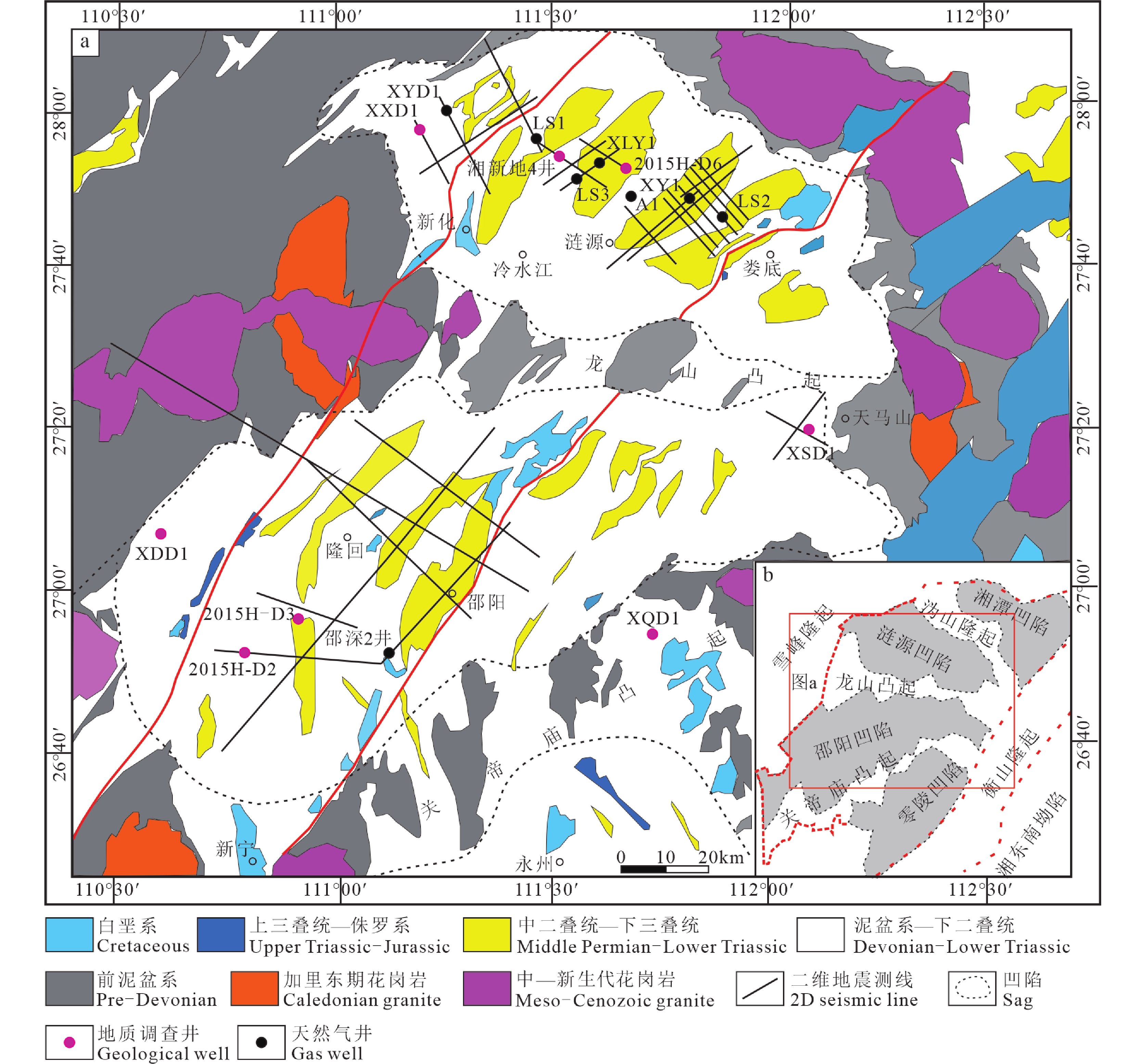
 下载:
下载:
